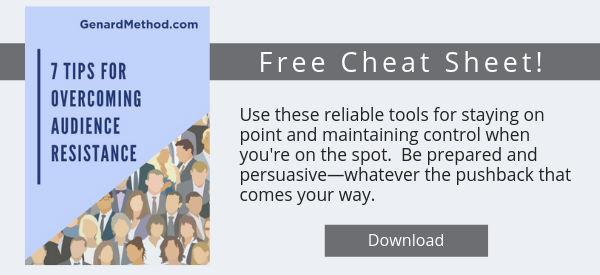
The other day, a consultant whose work I admire asked me for some advice. He was working with a client who was an excellent speaker. But when the Q & A began in this client’s presentations, things always took a turn for the worse.
That’s when the client developed what my friend called “verbal tics.” And he also began displaying nonverbal behavior that was a tip-off to his discomfort and anxiety. He clearly wasn’t relaxed in the question-and-answer dynamic, and it showed.
To go beyond run-of-the-mill performances in your own presentations and make what you say memorable, download my free cheat sheet, "5 Ways to Captivate an Audience."
When it comes to Q & A, I generally find that my speech coaching clients fall into two camps: (a) Those who love it (because they get to have a true conversation with their audience), or (b) Those who hate it (because they don’t know what’s coming).
Here are 5 things you can do to enjoy Q & A even more if you’re in the first camp, or to handle yourself more confidently and productively if you’re in the second.
1. Prepare for Topics that Are Relevant. Can you anticipate every question—or even every typeof question—you may be asked? Of course not. But whatever the human equivalent of a pretzel is, that’s what some speakers turn themselves into as they prepare for Q & A.
A pair of examples from my own experience concerning the from-out-of-nowhere question: Once, in a radio interview on body language, the host asked me what my favorite cuisine is in Boston (where I live), and London (where I studied acting). And in another radio interview—this one to promote my book Fearless Speaking—I was asked what song I would sing to get into heaven! The point here is that there will always be questions you won’t see coming. You’ll do well if you bone up on the areas of discussion you can reasonably anticipate.
Here's another great way to prepare from one of my previous blogs: by avoiding the 12 riskiest behaviors in a business presentation.
2. Tell Yourself, "I Can Answer That." Among my clients are political candidates and diplomats, two types of speakers who regularly face withering and even scornful questioning. In live television interviews, press conferences, and debates, a question may be asked that elicits a deer-in-the-headlights look even on the face of these skilled speakers.
So some years ago, I began to address these clients' nonverbal responses to this type of question. Since visuals predominate in an audience's mind when they see us answer, it’s important to look confident in the first couple of seconds after a tough question is asked. I began to suggest that my clients tell themselves silently, “I can answer that!” The truth is, of course, that they can. Showing such self-assurance is a force multiplier in both building credibility and feeling confident.
3. Answer Topics not Questions. As a speaker, you need to avoid at all costs assuming a defensive posture in Q & A. I call it the “flaming arrow syndrome”: Questioner shoots burning arrow at you up there on the castle battlements; you dodge out of the way; repeat as (un)necessary.
If you wait for each question like this, and then try desperately to think of something to say quickly, you’ll end up in a loop of endlessly defending your position. Instead, do what you’re actually primed to accomplish: Take every opportunity to make the points you came here to make. That is, use every question to bridge to the topic you’re prepared to discuss. A connection exists between that question (provided it’s a legitimate one), and the topic of your speech. Find a way to unapologetically get from one to the other. It’s a perfectly legitimate, and even a necessary, stratagem.
4. Use Evidence. Ever find yourself flopping around a speaking stage because you have nothing to back up the opinion you just stated? Chances are, it’s because you didn’t offer any evidence to support your claim.
Without evidence, your assertion never grows in stature beyond that very-nice-but-not-particularly-compelling opinion. As the old T.V. commercial used to say, “Where’s the beef?” Many forms of evidence exist—personal experience, expert testimony, statistics, research studies, client testimonials, stories, etc.—most of them strengtheners of your argument that will immediately boost your credibility. Using evidence is also a great way to break up a too-theoretical presentation.
5. Think Positively! Finally, remember this about Q & A: it’s your opportunity to convince your audience that you know your stuff, in ways your actual talk may not have accomplished. That’s why I call it “The Forgotten Avenue of Audience Persuasion.” Anyone who’s prepared and who has practiced sufficiently can give a reasonably good presentation. But the speaker who can handle himself or herself with style and equanimity while on the hot seat of Q & A, in the service of achieving true leadership presence . . . now you’re talking!
And this last point: If you’re going to spend all that time and energy thinking about and anticipating the speaking situation, why not make it a productive exercise? Thinking positively rather than negatively is one of the magic ingredients of a helpful self-fulfilling prophecy.
Here are more helpful tips on how to use positive thinking to speak more successfully. After all, if you get into that mindset, the odds will be ever in your favor.
You should follow me on Twitter here.



